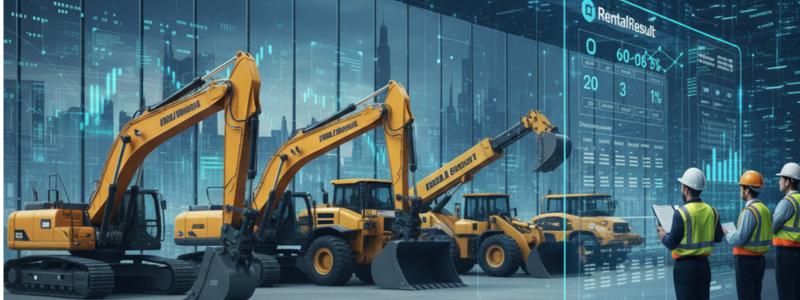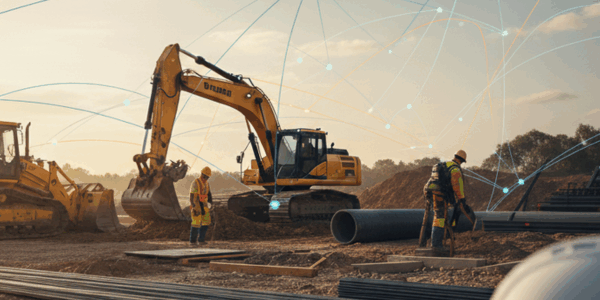
In construction, equipment is more than a resource—it’s an investment. Yet many contractors still manage assets reactively, relying on spreadsheets and disconnected systems that can’t keep pace with modern demands. As equipment costs rise and project schedules tighten, lifecycle management is becoming a defining factor in profitability and operational control.
Across the industry, leading contractors are moving toward smarter, data-driven lifecycle strategies—using integrated systems like RentalResult to bring every phase of equipment ownership, utilization, and renewal into one connected workflow.
From Reactive to Predictive: The Modern Equipment Mindset
Traditional lifecycle management follows a linear model: buy, use, maintain, replace. That approach worked when fleets were smaller and organizations had limited utilization data But today, contractors need to track hundreds—or even thousands—of assets across multiple projects, regions, and billing structures.
The shift now is toward predictive and data-informed management, powered by platforms that centralize asset data, automate maintenance schedules, and support proactive decision-making. Instead of reacting to downtime, equipment teams are using systems like RentalResult to anticipate it.
RentalResult’s construction equipment management software helps contractors analyze asset health, track performance trends, and plan maintenance before failure occurs. This turns maintenance from a cost burden into a predictable, controllable process that protects uptime and ROI.
In short: proactive management extends lifespan, reduces cost, and improves fleet reliability.
Trend 1: Data-Driven Lifecycle Planning
Equipment lifecycle management now starts with information—not instinct. The most successful contractors are consolidating data from procurement, maintenance, and operations into a single platform that shows the full financial and operational story of every asset.
With RentalResult’s integrated fleet management capabilities, contractors can see:
- Real-time utilization across all job sites.
- Total cost of ownership, from acquisition through disposal.
- Maintenance and downtime patterns that drive better replacement decisions.
That visibility transforms planning from reactive guesswork into strategic forecasting. Instead of overinvesting in new equipment, contractors can identify underused assets, extend high-performing ones, and time replacements precisely.
Takeaway: visibility into lifecycle data means smarter capital allocation and stronger ROI.
Trend 2: Integrated Systems Across the Equipment Ecosystem
For many firms, the biggest barrier to effective lifecycle management isn’t a lack of data—it’s that data lives in silos. Procurement, maintenance, rentals, and billing often operate independently, making it impossible to see the full picture.
That’s where integration becomes the differentiator.
A unified equipment management platform connects every stage of the lifecycle in one system—linking procurement with finance, scheduling with utilization, and field operations with billing. This integration ensures that data flows seamlessly across departments, improving control and eliminating redundancy.
Why it matters:
- Operations teams know exactly which assets are available and where.
- Finance gains real-time insight into utilization and cost recovery.
- Maintenance teams schedule service based on usage, not guesswork.
At scale, that integration enables contractors to run their equipment division like a business within the business—complete with transparent costs, accountable performance, and measurable profitability.
Trend 3: Extending Asset Value Through External Rentals
Idle equipment wastes capital. As contractors look to maximize ROI, external rentals are becoming a key part of lifecycle strategy. Rather than letting machines sit between projects, many enterprise contractors are renting their own assets to trusted subcontractors or partner firms.
RentalResult makes this process seamless. Its rental management functionality automates availability tracking, pricing, and billing, ensuring accuracy from contract to collection. Contractors gain full visibility into external utilization while maintaining control over maintenance schedules and asset condition.
By monetizing idle assets, equipment teams not only extend the lifecycle value of their fleet—they turn downtime into revenue.
In short: smart contractors make every hour of equipment ownership pay off.
Trend 4: Sustainability as a Lifecycle Metric
Today, sustainability isa major driver in construction equipment management. Clients, regulators, and investors increasingly expect transparency around emissions, fuel efficiency, and waste reduction. That’s pushing contractors to integrate environmental accountability into lifecycle decisions.
Through better tracking and utilization data, RentalResult helps contractors manage sustainability goals in practical, measurable ways:
- Reducing idle time and redundant transport between job sites.
- Tracking utilization to prioritize efficient, modern assets.
- Extending equipment life through proactive maintenance.
By embedding sustainability into lifecycle planning, contractors lower costs, improve asset efficiency, and strengthen compliance with emerging ESG standards—all while maintaining profitability.
Bottom line: sustainability and operational efficiency now go hand in hand.
Trend 5: Financial Intelligence and the Rise of “Max Cap” Awareness
Equipment management is as much about financial performance as operational control. Understanding an asset’s Max Cap—its maximum earning potential—is now a vital metric for lifecycle planning. When contractors know how much revenue an asset can generate versus its maintenance and ownership cost, decisions about replacement or reallocation become data-driven and defensible.
RentalResult brings financial intelligence to lifecycle management by connecting equipment usage with automated billing and cost recovery workflows. Every hour, rate, and maintenance expense is captured automatically, ensuring accuracy and accountability.
This eliminates the revenue leakage that often occurs with manual tracking. More importantly, it allows executives to measure true equipment profitability—turning fleet data into financial foresight.
In practice: automated billing and cost recovery elevate fleet management from reporting to forecasting.
Preparing for What’s Next
As construction firms continue to digitize, the next phase of lifecycle management will be defined by connected decision-making—where operational, financial, and utilization data all live within one ecosystem. That’s the model RentalResult was built for.
Contractors who adopt integrated lifecycle platforms gain an immediate edge: they reduce downtime, improve cost accuracy, and create a continuous feedback loop between the field and finance. Those still relying on spreadsheets and disconnected tools will find it harder to compete on efficiency or insight.
The question for 2025 isn’t whether to modernize lifecycle management—it’s how fast you can make the shift.
Strategic Takeaway
Equipment lifecycle management is no longer about tracking machines—it’s about managing value. The leading contractors of 2025 are uniting data, visibility, and financial control through systems like RentalResult, turning their equipment divisions into measurable profit centers.
Explore how enterprise contractors are extending asset life, recovering costs faster, and improving utilization with RentalResult’s equipment lifecycle management platform.




